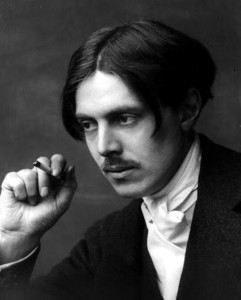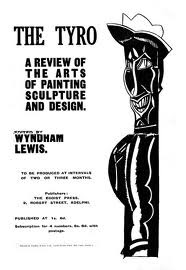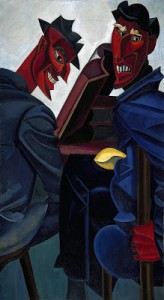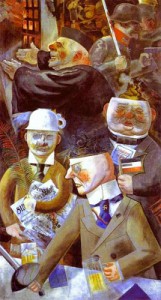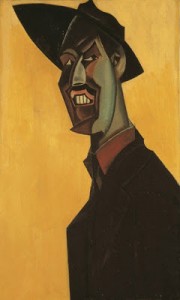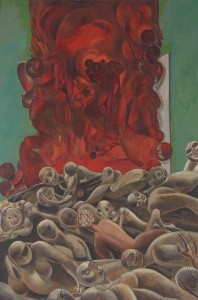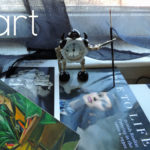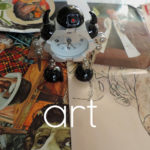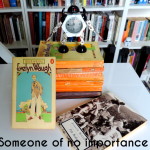It’s not just ‘the general public’ that sometimes finds abstract or conceptual art to be the empty, meaningless work of opportunistic charlatans; sometimes artists do too. While belonging firmly to the European avant-garde of his time, artist, poet and novelist Percy Wyndham Lewis (1882-1957) created a series of figurative works – the Tyros – which both stand outside of and satirise the modernist movement in a way that we would now recognise as ‘post-modern’ in their knowing, ironic nature.
While the satire of modernism was not new in Lewis’ art, the ‘Tyronic’ works of the 1920s mark the beginning of a wider programme (which included his relatively commercial portraiture of the period) which attempted not just to draw attention to the stagnation and decay which the artist perceived in post-WWI European culture, but also to put forward (somewhat half-heartedly) the aim of a new and rigorous ‘classical’ regeneration of both art and society. In the aftermath of the First World War, Lewis saw an opportunity to start afresh in an age in which artists were ‘creatures of a new state of human life.’[1]
With the Tyros, Lewis devoted himself to addressing, in his characteristically humorous and aggressive fashion, what he saw as lingering aspects of the old world, in particular the decadent ‘90s of Oscar Wilde & co and the limp quasi-modernism of the Bloomsbury group. However, much of the underlying philosophy of Lewis’ ‘new’ direction derives from the works – both literary and artistic – of his own earliest, pre-war maturity. The implications of this philosophy run far deeper than simply a criticism of the artistic milieu of 1920s Britain, addressing the very nature of humankind itself, with, typically of the artist, entirely negative conclusions. Indeed, Lewis’ vehement opposition to the apparently progressive movements of his time has often led to an overly simplistic (although understandable) denigration of the artist as a fascist. After an initial flirtation with the far-right, though, he was eventually to dismiss the simple-minded politics of fascism with exactly the same kind of aggressive amusement as he dismissed almost everything else. Much of the power of the ‘Tyronic’ works derives from the tension between the relatively positive aims of Lewis’ programme of regeneration and the basic negativity of his satire and personality. This tragic, even hopeless, view of humankind is integral to the satire of the Tyros as it lay at the very heart of Lewis’ conception of humour.
Wyndham Lewis introduced his Tyros in April 1921 at the Leicester Galleries, London, in an exhibition named Tyros and Portraits. Whereas the portraits could, to a certain extent, be seen as conventional, though modernist in style, the Tyros were intended to act as a shock awakening to the docile English spectator – ‘These Tyros’ he wrote in the introduction to the exhibition catalogue, ‘are not meant to be beautiful…they are, of course, forbidding and harsh.’ The Tyros represented a new mythology, a race of human creatures, fully grown, but new to life, reliant on gut emotional responses and free from reason or logic. As such, they are depicted (both in the finished paintings and in the drawings which illustrated his magazine, The Tyro) as grotesque figures, usually grinning, laughing* or sneering. In the magazine’s fictional works the Tyros are depicted as simple-minded fools, usually engaged in inane gossip, almost a prefiguring of the 21st century era of talent-free celebrity. As paintings, they are modernistic in style, but also embody the intellectual concerns that Lewis felt should be the domain of the artist.
*Lewis’ ambivalent feelings about humour were forcefully expressed in the Vorticist manifesto BLAST, where it is both cursed as ‘arch enemy of REAL’ and blessed as a ‘great barbarous weapon’. More about this below…
The figures of the Tyros, with their naive, childlike responses to life are, at first glance, not 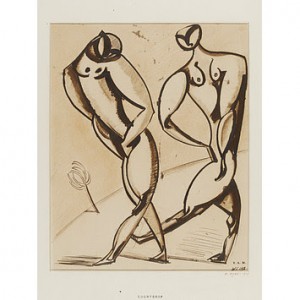 entirely new in Wyndham Lewis’s art. The theme of the human being as an instinctively motivated animal is a feature of both his art and writing from his earliest maturity. The Breton peasants of the Wild Body stories of 1909-17, crude and animalistic, have recognisable features in common with the Tyros. Artistically too, the subjects of his drawings, such as Dieppe Fisherman (1910) and Courtship (1912, right), share with the Tyros the signs of an intuitive, animal nature such as low foreheads, ridiculous postures and a general lack of individuality. His satire has more than one target – though the fisherman and the romantically engaged couple are, to Lewis, comical figures, they are merely representative samples of wider humanity; ‘’men’ are undoubtedly, to a greater or lesser extent, machines… Men are sometimes so palpably machines, their machination is so transparent, that they are comic.’[2] This point of view remained constant in Lewis’s philosophical worldview, but the Tyros nonetheless differ significantly from his earlier work.
entirely new in Wyndham Lewis’s art. The theme of the human being as an instinctively motivated animal is a feature of both his art and writing from his earliest maturity. The Breton peasants of the Wild Body stories of 1909-17, crude and animalistic, have recognisable features in common with the Tyros. Artistically too, the subjects of his drawings, such as Dieppe Fisherman (1910) and Courtship (1912, right), share with the Tyros the signs of an intuitive, animal nature such as low foreheads, ridiculous postures and a general lack of individuality. His satire has more than one target – though the fisherman and the romantically engaged couple are, to Lewis, comical figures, they are merely representative samples of wider humanity; ‘’men’ are undoubtedly, to a greater or lesser extent, machines… Men are sometimes so palpably machines, their machination is so transparent, that they are comic.’[2] This point of view remained constant in Lewis’s philosophical worldview, but the Tyros nonetheless differ significantly from his earlier work.
The First World War had an enormous impact on the generation who lived through it, Lewis included, as well as on that which came after. Before the war, Lewis was already a public figure – the outspoken leader of the UK’s own avant-garde art movement, the Vorticists. This celebrity was not to survive the war, and neither was the public enthusiasm for (or at least amusement with) the modern art which had created it. Whereas in 1914/15, Lewis’s work had approached complete abstraction, he now found the hard-won achievements of the Vorticist period ‘bleak and empty. They [the abstract geometric forms] wanted filling.’[3] The Tyros and Portraits exhibition was Lewis’s first major attempt at fulfilling this goal. With these works he attempted to address the problems with modern art – its lack of contact with or interest in real life, its obsession with the fleeting and transient and its preoccupation with the intuitive and sensual (exemplified slightly later by Ben Nicholson and Kit Wood’s ‘discovery’ of the ‘naive’ painter Alfred Wallis) which, to Lewis, democratised and undermined the skilled, privileged position of the artist, whose role as documenters (and even creators) of culture and guardians of the intellectual heritage of humankind entailed a sense of responsibility which he felt was being betrayed by the artistic elite of his time. Therefore, the satire of the Tyros is intensified by a moral element which had not been present in his depiction of humanity in the pre-war period.
The primary target of Lewis’s satire, epitomising all that he felt was wrong with modern art, was the Bloomsbury group. Lewis’s enmity towards this group and in particular its leader, 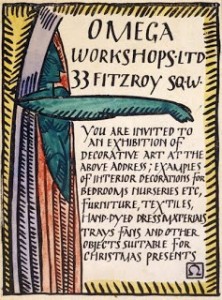 Roger Fry, dated back to the pre-war period when he and his fellow Vorticists left Fry’s Omega Workshops in acrimonious circumstances. Lewis’s view of the Bloomsbury group in 1913 – ‘the idol is still Prettiness, with its mid-Victorian languish of the neck’[4] – was not significantly altered by the intervening years and in fact his attitude was probably hardened by the suspicion that the group had underhandedly used the period of the Great War (the group was, in stark contrast to the Vorticists, largely composed of conscientious objectors) to consolidate their standing as the modern art movement in the UK. Despite the obvious paranoia inherent in this point of view, it is certainly the case that the Omega Workshops heightened its profile during the war years, selling its products more widely than earlier, as well as holding the first exhibitions of Children’s Art in 1917, a venture that seemed to encapsulate everything that Lewis felt about the group.
Roger Fry, dated back to the pre-war period when he and his fellow Vorticists left Fry’s Omega Workshops in acrimonious circumstances. Lewis’s view of the Bloomsbury group in 1913 – ‘the idol is still Prettiness, with its mid-Victorian languish of the neck’[4] – was not significantly altered by the intervening years and in fact his attitude was probably hardened by the suspicion that the group had underhandedly used the period of the Great War (the group was, in stark contrast to the Vorticists, largely composed of conscientious objectors) to consolidate their standing as the modern art movement in the UK. Despite the obvious paranoia inherent in this point of view, it is certainly the case that the Omega Workshops heightened its profile during the war years, selling its products more widely than earlier, as well as holding the first exhibitions of Children’s Art in 1917, a venture that seemed to encapsulate everything that Lewis felt about the group.
Lewis’s complaints about Bloomsbury were not entirely without foundation. Roger Fry and Clive Bell were, to the art world in France and elsewhere, the face of the English avant-garde, but they failed to use what little influence they had to promote English art outside of their own somewhat cosy coterie – indeed, even artists broadly in sympathy with their aims and methods – such as Ben Nicholson – did not receive the kind of support they could perhaps have expected. Similarly, Lewis’s claim that Fry, Bell and Duncan Grant were dilettantes (and therefore related to the novice status of the Tyros), ‘playing’ at art without any intellectual seriousness is not entirely without foundation. Even the relatively grander theories of the group (such as ‘significant form’) seem, in practical execution, to correspond with Lewis’s picture of ‘colour-matching, matchbox-making, dressmaking, chair-painting…tinkerers.’[5] Comments such as Fry’s ‘After all, there is only one art; all the arts are the same’[6] or even worse, Clive Bell’s crass use of a sporting metaphor to grade the differing qualities of French versus English artists (‘the English is normally a stone below the French’[7]) strengthen the validity of Lewis’s claims.
The vision of the amateurish, pseudo-intellectual, self-consciously ‘artistic’ figure of the Bloomsbury artist lent itself easily to the grinning, elemental figures of the Tyros. Probably the most powerful work on display in the Tyros and Portraits exhibition was the large (165.1 x 88.9cm) oil painting, A Reading of Ovid (Tyros) of c. 1920.
A Reading of Ovid
This painting, acknowledged by Lewis as one of his most carefully finished works, shows two Tyros disturbed in the act of reading. The humour of the satire derives from the juxtaposition of the vacantly grinning masklike faces of the two figures with the intellectual pastime they are engaged in. This corresponds with Lewis’s extremely bleak theory of the comic in general; ‘in one sense you ought to be just as much surprised at finding a man occupied in this way [reading] as if you had found an orchid or a cabbage… The movement or intelligent behaviour of matter – any autonomous movement of matter, is essentially comic.’[8] At the same time, the satire is more pointed and direct – these ridiculous figures are, as Lewis explained, an attempt to ‘frighten away the bogey of ‘art for art’s sake’’, the basis for the ‘cultivated and snobbish game’ of English art,[9] art which had no root in culture or society, but was an activity – even a hobby – driven only by the whim of the artist. This satire is especially barbed when one takes into account Lewis’s elevated view of the artist as a cultural leader – and whatever his evaluation of Roger Fry’s talent, Lewis did accept that he was a ‘sensitive and real being’ outside of the homogenous and unthinking mass of the general public. He might therefore be expected to feel the sting of the satire keenly. If the foreword to the exhibition catalogue was not specific enough, the clothing of the Tyros in A Reading of Ovid; the baggy suits and the foppish, ostentatious handkerchief, identifies them clearly as the dilettante artists described in Lewis’s 1918 novel, Tarr; ‘the art-touch, the Bloomsbury technique, was very noticeable. Hobson’s tweeds were shabby, from beneath his dejected jacket emerged a pendant seat, his massive shoes were hooded by the superfluous inches of his trousers: a hat… shaded unnecessarily his countenance.’[10]
In contrast to the directness of his visual attack on Bloomsbury, the use of Ovid as the text over which the Tyros grin, leaves the scene open to several interpretations. This may in itself be a joke on Lewis’s part; the author of the Metamorphoses being evoked in a picture which shows primitive ‘elementals’ attempting to transform themselves by aping the manners of their intellectual superiors. It is also possible that Ovid was chosen as the classical author best known for his erotic works, such as The Art of Love, and that the Tyros are simply shown sniggering over the ‘dirty bits’ of one of the world’s great authors, as befits their base, sensual outlook. Yet another interpretation, with wider-reaching conclusions, is that the use of Ovid refers to the ‘return to stability’ within the French avant-garde of the post-war period, a neo-classical revival looking back to Ingres and David. Lewis, with his own leanings towards a new classicism, was scornful of this fad, which he saw as a French retreat into a safe, patriotic ‘mother-tradition’.[11] In this reading of the painting, the pseudo-intellectual Tyros are engaged in a futile attempt to build a new thought-world, entirely grounded in the past. Lastly, it is possible that the use of Ovid as a figure beyond the reach and understanding of the childlike Tyro is a piece of somewhat arrogant self-identification. Ovid, like Lewis, was an outsider figure, both in his own time and in subsequent literary history, and had been excluded from the elite of his own day for the subversive and satirical nature of his art.[12] The arrogance suggested by this interpretation is not at all inconceivable when looked at in the context of Lewis’s artistic programme of this period – his criticism of Fry in particular seems to suggest that a more suitable figurehead for English modernism would be a professional artist and genuine intellectual – i.e. Lewis himself.
Whatever his pretensions, A Reading of Ovid presents vivid evidence of Lewis’s outsider status in the context of European modernism. As a painting, it has little parallel in Europe at that time. The figures, though influenced by cubist ‘primitivism’ in their hard-edged, geometric, non-naturalistic outlines, bear little resemblance to extant cubist art. Likewise, although effective satire was being produced by Francis Picabia, Marcel Duchamp and (most notably) by the German Expressionist George Grosz, their art has little in common with Lewis’s bizarre vision. Nor do these artists share the scope of Lewis’s aims, balancing artistic, social and philosophical concerns, making the Tyro paintings, as he explained, ‘at once satires, pictures and stories.’[13] Lewis, devoted to the cause of ‘art’ in a way that was anathema to the Dadaists, totally eschewed the iconoclastic playfulness of Picabia and Duchamp. The power of Grosz’s art often derives from the passionate rendering of the artist’s bitterness and disgust with the decay and corruption of post-war Germany, where the economic, social and political situation was far more unstable and extreme than in France or England.
Grosz, The Pillars of Society
Lewis’s view of satire did not intend to have the emotional, inflammatory impact of work such as Grosz’s; Lewis declared that ‘satire is cold… the non-human outlook must be there.’[14] It is this coldness that allows the intellectual response that Lewis desired in the viewer. The only real parallels for A Reading of Ovid are in fact in the earlier works of Lewis himself. The effective, non-naturalistic colour scheme of opposed visceral reds and deep metallic blues had been a feature of his art since his earliest, Futurist-inspired works. This colour scheme is the opposite of the warm, harmonious, Matisse-influenced and decorative style of the Bloomsbury painters, and so fulfils the dual function of preventing a sensual response (thereby inviting an intellectual one) and providing a corrective example to contemporary Bloomsbury practice. The composition has a tense vitality which is achieved in a similar way to that of his pre-war abstract works such as Composition (1913, left). This energy comes not from loose, free, energetic 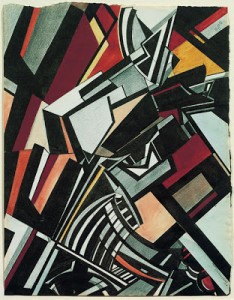 brushwork, but from the way in which the dynamic and surging forms of the Tyros, as with those of the abstract works, are locked into a tense design by firm, clean outlines. The power of the line imprisons the energy of the composition, creating an image which is static, but bursting with potential movement. The vitality is, in the Tyros, not merely abstract ‘design’, but also an integral part of the subject.
brushwork, but from the way in which the dynamic and surging forms of the Tyros, as with those of the abstract works, are locked into a tense design by firm, clean outlines. The power of the line imprisons the energy of the composition, creating an image which is static, but bursting with potential movement. The vitality is, in the Tyros, not merely abstract ‘design’, but also an integral part of the subject.
The vital energy of the Tyros was stressed in Lewis’s writings, and expressed in their grotesque laughing faces. Laughter, to Lewis, was an important philosophical concept. The ‘wild body’ of the human animal, said Lewis, ‘triumphs in its laughter. Laughter does not progress. It is primitive, hard and unchangeable.’[15] The world this laughter reveals is that of the human animal in its true element, stripped of all artifice. In issue two of his magazine The Tyro, Lewis included a ‘Tyronic dialogue’, in which ‘X’, a Tyro representing Lewis himself, makes the following assertion to his more naive companion – ‘Every civilised milieu is… the devouring jungle driven underground, the instinct of bloody combat restricted to forensic weapons.’[16] This underlying reality, masked by complex human behaviour is also hinted at in smaller works, such as the Tyro Madonna (1921, below right) where religion and sexuality are combined in a totem-like image which seems to satirise the edifices built upon the baser instincts of mankind. Laughter brings this subterranean Darwinian world to the surface – and satire, though a form of criticism, aims partly to provoke an amused response in the viewer. This laughter is, like all laughter, an instinctive reaction, and therefore a tragic reminder of the inescapable fate of the human being – to live and therefore to die as an animal like any other. We are laughing with the Tyros as well as at them.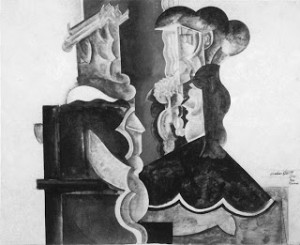
The use of satire, had then, despite its appeal for Lewis, extremely negative connotations. In appealing to the sense of humour, it is the denial of the classicism which he himself had put forward in his portraits as the basis of a new modern art, and in fact the denial of all meaningful progress. Although he attacked the situation of the arts in England vigorously, privately he declared that ‘it would be unwise to regard [this state of affairs] as anything but permanent.’[17] The truth of this remark must have seemed self-evident in the irony that A Reading of Ovid was purchased by one of the leading members of the late-Victorian dilettante class, Osbert Sitwell, himself a butt of Lewis’s satire. Whatever his hopes for the future of art and society, Lewis had, fundamentally, a pessimistic view of humankind. This pessimism, a feature of Lewis’s thought since his early maturity and sharpened by the influence of T.E. Hulme, had been, not surprisingly, deepened by the events of the First World War. The art historian David Peters Corbett claims that Lewis was ‘too satirical’ to show his mourning in his art[18] but in fact, the Tyros themselves, in their elemental stupidity, can be interpreted as a bleak kind of mourning for the pointlessness of the mass slaughter of 1914-18.
The Tyros, vessels for the raw energy and vitality of the human animal, necessarily display none of the stillness and ‘deadness’ which Lewis saw as essential to the creation of an ‘immortal’ classical art, and by their very theme, deny the truth of such an art. However, classicism’s loss is satire’s gain, as the concentration on the eternal truth of the real nature of civilisation paradoxically gives the Tyros a timelessness that transcends the immediate situation they satirise, making them of more than socio-historical interest.
The wide-ranging satire and deep pessimism of Lewis’s outlook did not spare even the intellectual elite which he saw as the ideal leaders and creators of a new culture. The culmination of his ‘Tyronic’ period is the one of the most extraordinary paintings of his career; the self portrait Mr Wyndham Lewis as a Tyro (1920/1).
Mr Wyndham Lewis as a Tyro
This painting shares many features with A Reading of Ovid. The colour scheme has dramatic contrasts of dark and light, creating a dramatic tension, again denying the comfortable sensual response of most Bloomsbury art. The composition is jagged and stark, containing great energy within tightly enclosed boundary lines. The Tyro bares his teeth in a sneer, looking disdainfully past the viewer from under the aggressive sweep of his hat. In contrast to the average Tyro his forehead is high, but the facial expression (and his status as a Tyro) suggests animal cunning rather than intelligence. While promoting the exhibition, Lewis stated in an interview with the Daily Express that the vitality of the Tyro is ‘purposeless, and hence sometimes malignant’[19] and this is the aspect we see here. The Tyro sneers at the viewer, revealing the basic, negative instinct underlying Lewis’s complex criticism of art and society. Given that Lewis had repeatedly stated his views on the ultimate tragedy of human life, the ‘terrible nature of its true destiny’[20] as revealed by Darwin, it is not inconceivable that the self-portrait depicts Lewis’s real ‘animal self’, sneering at the somewhat romantic ideal of immortality through art that the artist fostered through his intellectual ambitions. Given the nihilism that formed the heart of Lewis’s worldview, the animal response, the sneer or laugh of the Tyro was the only valid one when confronted by the essential joke of human consciousness. Ultimately, the Tyros invite the audience to laugh with as well as at them; to mock the ridiculousness of humankind and to sneer at its pretensions and aspirations.
With the Tyros, Wyndham Lewis created a mythology based on the essential transience of human life and the animal impulses which ultimately guide all of our seemingly civilised pursuits. In the end, as the artist no doubt expected, the Tyros failed to accomplish much beyond consolidating Lewis’s position as an antagonistic troublemaker in the art world of inter-war England. In the build up to World War Two, Lewis isolated himself even further with some misjudged political writings, and pursued the pessimism of the Tyros on a bigger, more generalised scale with powerfully negative works such as Two Beach Babies (1933, below) and Inferno (1937, above). Post WW2 though, despite completing his massive, Dante-esque mythological trilogy of novels, The Human Age, he was never to regain either his power as an artist or his standing as a public figure.
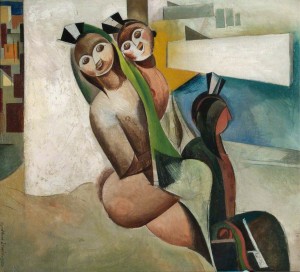
[1] Wyndham Lewis, ‘The Children of the New Epoch’ from The Tyro No.1 available to download at http://dl.lib.brown.edu/pdfs/116015166093419.pdf
[2] Lewis, Men Without Art (1934)
[3] Lewis, Rude Assignment: A Narrative of my Career Up-to-Date (1950)
[4] Lewis, Etchells, Hamilton & Wadsworth, in WK Rose (Ed), the Letters of Wyndham Lewis (1963)
[5] Lewis, The Caliph’s Design (1919)
[6] Fry, quoted in J. Ferguson’s The Arts in Britain in World War One (1980)
[7] C. Bell, quoted by Lewis in The Letters of Wyndham Lewis
[8] Lewis, The Wild Body (1928)
[9] Lewis, The Wild Body (1928)
[10] Lewis, Tarr, 1918
[11] Lewis, The Caliph’s Design
[12] Ovid, The Erotic Poems (trans. P. Green, 1982)
[13] Lewis, The Wild Body
[14] Lewis, Men Without Art (1934)
[15] Lewis, The Wild Body
[16] Lewis, The Wild Body
[17] Lewis to J. Quinn, The Letters of Wyndham Lewis
[18] Peters Corbett (Ed) Wyndham Lewis and the Art of Modern War (1998)
[19] Quoted in The Complete Wild Body (1982)
[20] Lewis, The Wild Body


